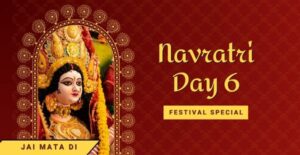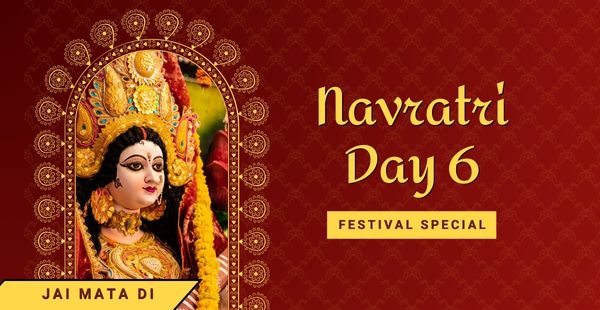
Celebrating Navratri 2024: As we immerse ourselves in the vibrant celebrations of Navratri 2024, Day 6 holds a special significance in the hearts of devotees across India and around the world. This nine-night festival, dedicated to the worship of Goddess Durga, is a time of spiritual rejuvenation, community bonding, and exuberant celebration. Day 6, in particular, is a pivotal moment in the Navratri festivities, marked by deep devotion and the enchanting rhythms of dance. In this blog, we will explore the cultural and spiritual essence of Navratri Day 6, the significance of the goddess worshipped on this day, and how people celebrate with fervor and joy.
The Significance of Navratri
Navratri, which translates to “Nine Nights,” is a major Hindu festival celebrated twice a year, in the spring and autumn. The festival honors the divine feminine energy embodied by Goddess Durga and her various forms. Each day of Navratri is dedicated to a different incarnation of the goddess, symbolizing the triumph of good over evil.
The festival involves fasting, prayer, and vibrant celebrations that include traditional dance forms like Garba and Dandiya Raas. It is a time for devotees to cleanse their minds and souls, seek blessings, and strengthen their faith.
Day 6: Celebrating Maa Katyayani
On Day 6 of Navratri, devotees worship Maa Katyayani, the sixth form of Goddess Durga. She is often depicted as a warrior goddess, symbolizing strength and courage. According to Hindu mythology, Maa Katyayani was born to sage Katyayana to eliminate the buffalo demon Mahishasura, who terrorized the heavens. Her fierce form represents the power to combat evil and protect the righteous.
Maa Katyayani is typically worshipped through rituals that invite her blessings for strength, wisdom, and protection. Devotees engage in Maa Katyayani worship by chanting her mantras and performing ceremonies, seeking her guidance in overcoming obstacles and challenges in their lives.
Rituals and Worship on Day 6
The rituals performed on Day 6 of Navratri are deeply rooted in tradition. Devotees start the day with early morning prayers, often at sunrise, as it is considered an auspicious time for worship. Homes and temples are adorned with flowers, colorful decorations, and images of Maa Katyayani.
Maha Aarti and Puja
Devotees gather for the morning Aarti, a ceremonial worship involving the singing of hymns and the offering of light to the goddess. The rituals include the offering of fruits, sweets, and other delicacies, showcasing devotion and gratitude.
Chanting Mantras
Mantras dedicated to Maa Katyayani are recited with devotion. Popular mantras like the “Katyayani Mahamantra” and the “Durga Saptashati” are believed to invoke the goddess’s presence and blessings.
Fasting
Many devotees observe fasts on this day, consuming only specific food items or abstaining from food altogether. Fasting during Navratri is seen as a way to purify the body and mind and express devotion.
The Dance of Celebration: Garba and Dandiya Raas
One of the most captivating aspects of Navratri is the vibrant dance celebrations that occur each night. Day 6 is no exception, as devotees engage in Garba and Dandiya Raas, traditional dance forms that celebrate the goddess’s spirit.
Garba
Originating from Gujarat, Garba involves circular dances performed around a central lamp or image of the goddess. The rhythmic clapping and movements create a sense of unity among participants, allowing them to express their joy and devotion. The dance is often accompanied by folk music, enhancing the celebratory atmosphere.
Dandiya Raas
Dandiya Raas involves dancers wielding colorful sticks (dandiyas) and moving in intricate patterns. This dance represents the playful and joyful aspects of worship. Participants often wear traditional attire, adding to the festive spirit. The colorful outfits, along with the lively music, create a mesmerizing spectacle that captures the essence of Navratri.
Community Bonding and Cultural Heritage
Navratri, especially Day 6, is not just about individual devotion; it is also a time for community bonding. In towns and cities across India, large gatherings are organized where people come together to celebrate.
Community Cultural Programs
Many communities organize community cultural programs, including dance competitions, music performances, and drama depicting the goddess’s stories. These events foster a sense of belonging and keep the cultural heritage alive for future generations.
Food and Festivities
The festival is also a time for culinary delights. Traditional dishes are prepared, and community feasts are organized, where everyone shares food and joy. Special dishes like Sabudana Khichdi, Kuttu Ka Dosa, and various types of sweets are prepared during this time, making the celebrations even more delectable.
The Spirit of Giving: Charity and Service
During Navratri, especially on Day 6, many devotees engage in acts of charity and service. This reflects the true spirit of the festival, emphasizing the importance of compassion and generosity.
Helping the Needy
Many individuals and families take this opportunity to donate food, clothes, and other essentials to those in need. This act of giving is believed to bring blessings and further the cycle of positivity and goodwill.
Supporting Local Artisans
Some communities also promote local artisans by purchasing traditional attire, jewelry, and decorations. Supporting local crafts not only helps the economy but also preserves cultural heritage.
The Global Celebration of Navratri
While Navratri has its roots in Indian culture, the festival has transcended geographical boundaries. Across the globe, the Indian diaspora celebrates this festival with equal fervor. Cities like London, New York, Toronto, and Sydney host grand Navratri events, where people come together to dance, sing, and worship.
Cultural Exchange
These global celebrations often serve as platforms for cultural exchange, where people from different backgrounds come together to experience the richness of Indian traditions. The participation of non-Indians in Garba and Dandiya nights signifies the universal appeal of Navratri.
Online Celebrations
In recent years, online celebrations have gained popularity, allowing people to participate in virtual dance sessions, prayers, and community gatherings. This digital adaptation ensures that the spirit of Navratri remains alive, even for those unable to attend in person.
Reflections on Spiritual Growth
As Day 6 of Navratri unfolds, it offers a unique opportunity for spiritual growth reflections. Devotees often take this time to contemplate their personal journeys, seek guidance, and reaffirm their commitments to their spiritual paths.
Meditation and Introspection
Engaging in meditation and introspection can help individuals connect more deeply with Maa Katyayani’s energy. This practice encourages mindfulness and a greater understanding of one’s inner self.
Setting Intentions
Many devotees set intentions for the remainder of the festival, focusing on areas of their lives they wish to improve or challenges they wish to overcome. This act of intention-setting aligns with the goddess’s empowering energy, fostering a sense of purpose.
As we celebrate Day 6 of Navratri 2024, we embrace the divine energy of Maa Katyayani, acknowledging her strength, courage, and compassion. This day serves as a reminder of the power of devotion, community, and the joyful celebration of life. Whether through prayer, dance, or acts of kindness, each of us contributes to the vibrant tapestry of Navratri.
Let us come together to honor the goddess, celebrate our cultural heritage, and foster a sense of unity and love within our communities. As the night falls and the music plays, may we all find our rhythm in the dance of devotion, celebrating not just the goddess, but the spirit of life itself.

